Imagine a Sunday morning with sunlight in the kitchen and the smell of Baked cheese croissant. These pastries are more than food; they make any moment special.
We love making baked cheese croissants with buttery layers and cheesy filling. They’re loved in homes and bakeries alike. It’s a celebration of cooking skill.
We’ll show you how to make a cheese croissant that’s crispy outside and cheesy inside. Our guide is for both experienced bakers and curious food lovers. We’ll take you through every step of making this delicious treat.
Key Takeaways
- Master the art of creating perfectly flaky pastry
- Learn professional techniques for cheese croissant preparation
- Discover versatile filling and cheese options
- Understand the science behind achieving golden-brown crust
- Explore serving and pairing recommendations
- Gain insights into make-ahead and storage methods
Introduction to French Viennoiserie Magic
The world of french viennoiserie is a culinary art. It turns simple ingredients into amazing bakery treats. Our journey starts with the iconic cheese croissant, a pastry that shows the beauty of artisanal baking.
French bakers have mastered the art of making savory croissants. They mix butter, flour, and creativity in a special way. These pastries are more than food; they’re a cultural symbol of precision and passion.
History of Cheese Croissants
The cheese croissant’s history goes back to European bakeries. Skilled artisans developed new techniques that changed pastry making. They experimented with layering to create the flaky texture we love today.
- 12th-century origins in Austrian kipferl
- Refined in France during the 19th century
- Transformed into modern cheese variations
Cultural Significance in French Bakery
In France, croissants are more than breakfast. They show the art of culinary craftsmanship. Each bakery has its own way of making these delicate pastries.
| Bakery Region | Unique Cheese Croissant Characteristic |
|---|---|
| Paris | Classic butter-rich style |
| Normandy | Local cheese integration |
| Provence | Herb-infused cheese filling |
Evolution of Modern Variations
Today, bakers are always innovating. They create new savory croissants that mix old techniques with new flavors. Artisanal baking uses global ingredients but stays true to french viennoiserie traditions.
“A great croissant tells a story of tradition, skill, and innovation.” – Master French Baker
Essential Ingredients for Perfect Baked Cheese Croissant
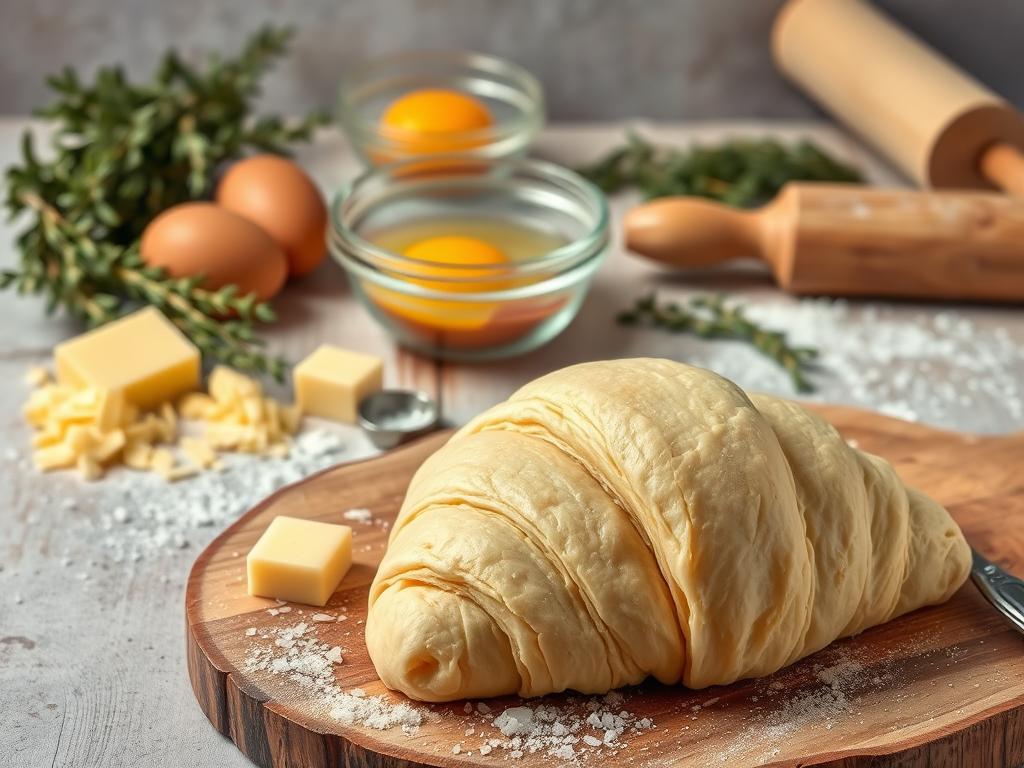
Making the perfect cheese-filled breakfast pastry starts with top-notch ingredients. Our journey to a delicious cheese croissant begins with the right mix. This mix turns simple dough into a tasty treat.
Let’s look at the key ingredients that make your cheese croissant special:
- Flour: High-protein bread flour makes the layers buttery
- Fresh yeast for the best rise and texture
- European-style unsalted butter (the highest quality)
- Premium cheese for the filling
Our top cheese picks add amazing flavor to your breakfast pastry:
| Cheese Type | Flavor Profile | Melting Quality |
|---|---|---|
| Gruyère | Nutty, complex | Excellent |
| Brie | Creamy, mild | Smooth |
| Mozzarella | Mild, stretchy | Perfect for strings |
Pro tip: Mix different cheeses for a unique filling. It will make your croissants unforgettable!
The secret to an amazing cheese croissant lies in the quality of ingredients and the love you put into making them.
Make sure all ingredients are at room temperature. This ensures they mix well and taste great. Your kitchen will soon smell amazing, filled with freshly baked, cheese-filled croissants!
Mastering the Art of Croissant Dough
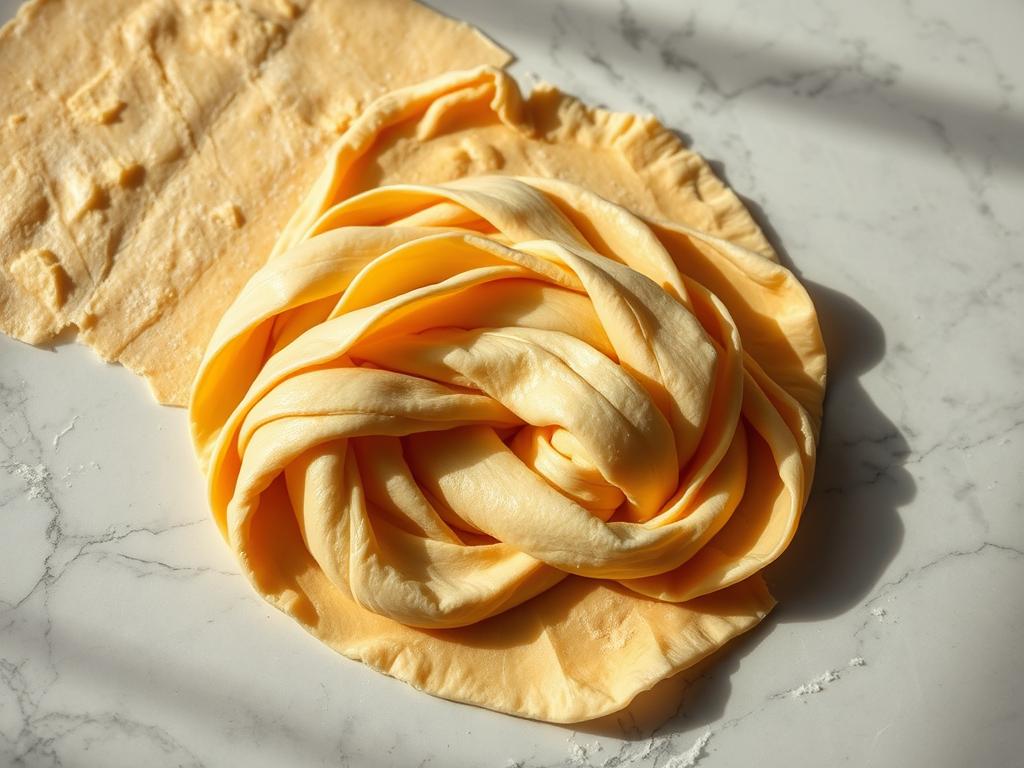
Making the perfect flaky pastry is an art that needs precision, patience, and passion. Our journey starts with learning how to prepare croissant dough.
The magic of buttery layers comes from a technique called lamination. This process turns simple ingredients into a culinary masterpiece. It promises a golden brown crust with every bite.
Lamination Technique Unveiled
Lamination is the secret to those dreamy, flaky layers that make croissants irresistible. Here’s how we do it:
- Prepare a precise dough mixture using high-quality ingredients
- Create a butter block that’s perfectly pliable
- Fold and roll the dough multiple times to develop layers
- Maintain consistent temperature throughout the process
Temperature Control Essentials
Achieving the perfect croissant requires careful temperature management. We suggest:
- Keep dough and butter between 60-65°F
- Chill dough between folding sessions
- Use a digital scale for precise measurements
- Work quickly to prevent butter from melting
Achieving Perfect Layers
The key to extraordinary croissants is patience and technique. Each fold adds layers, turning your dough into a breathtaking pastry. It has delicate, buttery sheets that melt in your mouth.
Pro tip: Think of lamination as creating a delicious architectural masterpiece with butter and flour!
For professional-level results at home, we recommend using a French rolling pin, digital scale, and metal bench scraper.
Cheese Selection and Preparation
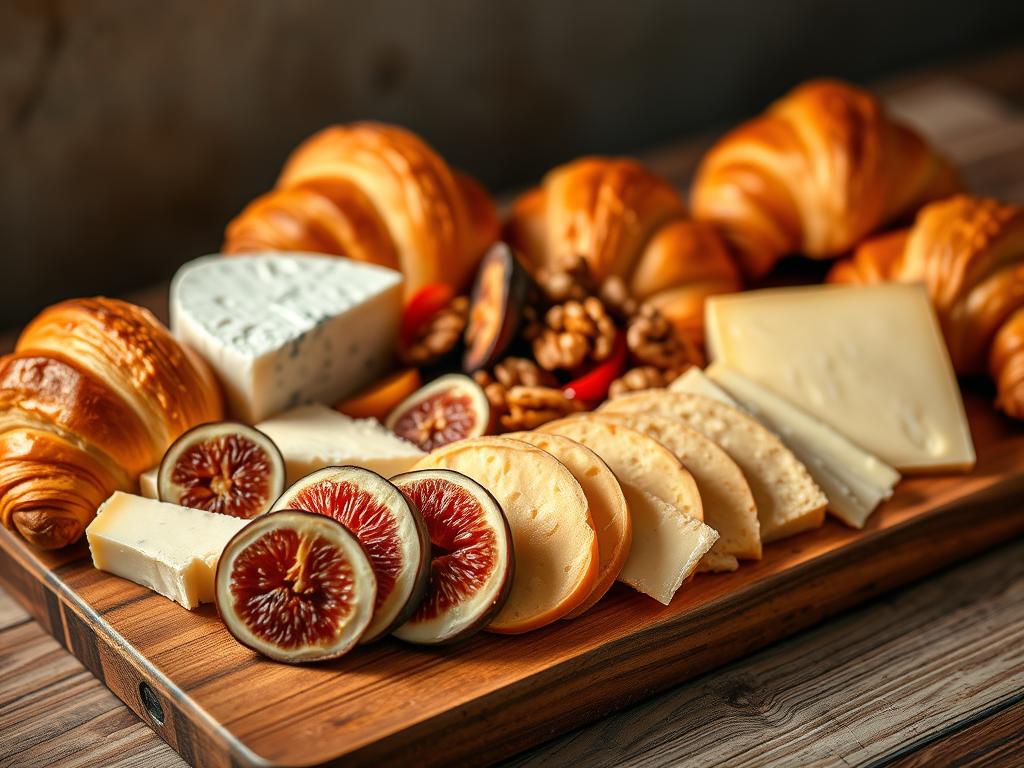
Making the perfect baked cheese croissant starts with picking the right cheese. We dive into the art of choosing and preparing cheese. This turns a simple croissant into a special treat.
Start with Swiss cheese for your filling. It melts well and has a nutty taste. This makes the croissant creamy and flaky.
- Top cheese choices for melted cheese perfection:
- Swiss cheese: Classic and reliable
- Gruyère: Rich and complex flavor
- Brie: Creamy and luxurious
- Camembert: Intense and smooth
Layering different cheeses is key. Use about 1.5 cups of shredded Gruyère or Swiss cheese. Sprinkle cheese on the croissant bottom to avoid sogginess.
Cheese is not just an ingredient – it’s the heart of your culinary creation!
Try mixing cheeses for a richer taste. Layer Gruyère, ham, and Brie or Camembert. A drizzle of Hollandaise sauce adds richness.
- Cheese preparation tips:
- Shred or slice cheese for even melting
- Bring cheese to room temperature before use
- Sprinkle extra cheese during final baking minutes
The quality of your cheese matters. Choose cheeses that melt well and taste great with the pastry.
Step-by-Step Baking Guide
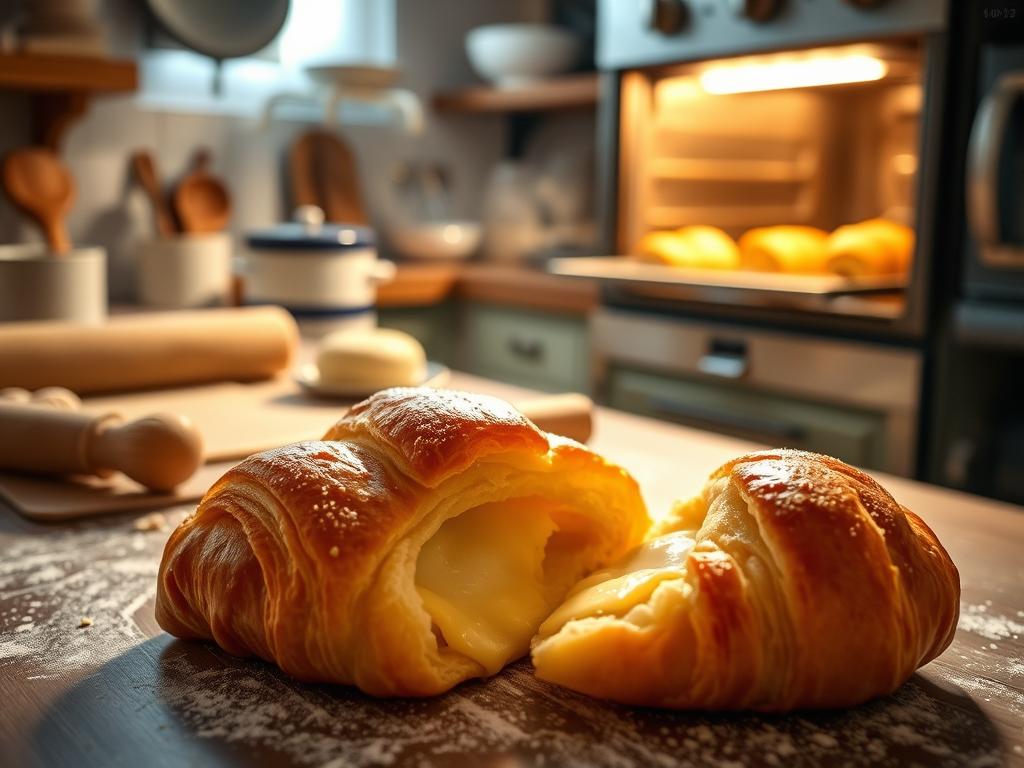
Making the perfect baked cheese croissant is an art. It turns a simple breakfast treat into a golden brown masterpiece. Our guide, inspired by French bakeries, will show you how to get bakery-quality results at home.
Proofing Your Croissants to Perfection
The proofing process is key for flaky layers. Follow these steps:
- Let croissants rise in a warm, draft-free area
- Keep the temperature at 75-80°F
- Cover them loosely with a clean towel
- Proof for 1-2 hours until they double in size
Mastering Baking Temperature and Timing
When baking your cheese croissant, precision is essential. Our method ensures a crisp outside and melted cheese inside:
- Preheat your oven to 375°F (190°C)
- Use a cookie sheet lined with parchment paper
- Bake for 15-18 minutes
- Rotate the sheet halfway for even browning
Visual Doneness Indicators
Knowing when your croissant is done requires a keen eye. Look for these signs:
- Golden brown color across the entire surface
- Crisp, flaky exterior that looks slightly puffy
- Cheese melted and bubbling slightly
- Edges that are deep amber and crisp
“A perfectly baked croissant should sing when it comes out of the oven – crisp, golden, and irresistible!” – French Pastry Chef
With these techniques, your kitchen will become a French bakery. You’ll make breakfast treats that impress everyone!
Creating the Perfect Golden Crust
Mastering the golden crust is key to exceptional artisanal baking. In our French bakery tradition, getting that perfect exterior takes precision and technique. The golden crust shows off your baking skills.
Now, let’s explore the secrets of a flaky pastry with a golden brown finish. It’s all about temperature, technique, and timing.
- Use European-style butter with 85% fat content for optimal results
- Prepare a perfect egg wash mixture
- Control oven temperature precisely
Our egg wash technique turns ordinary croissants into bakery-worthy delights. Mix 1 egg, 1 egg yolk, and a pinch of salt for the ultimate golden sheen.
| Baking Parameter | Recommended Setting |
|---|---|
| Oven Temperature | 365°F-425°F (185°C-218°C) |
| Baking Time | 10-25 minutes |
| Egg Wash Applications | 2 times during baking |
Temperature control is key. Your butter should be like clay – firm yet pliable. This helps in even layering and prevents butter from pooling, which can ruin your golden crust.
The difference between a good and great croissant is often in the details of its crust!
Look for visual cues: your cheese croissant is ready when it’s a deep, uniform golden brown. It should have beautiful, crisp ridges that show off your baking skills.
Serving Suggestions and Pairings
Turn your baked cheese croissant into a gourmet snack that pleases the senses. These savory croissants are perfect for any time, with the right pairings and presentation.
Discover how to make your indulgent snack even better. We’ll show you the best pairings and presentation tips to wow food lovers.
Perfect Beverage Companions
Your cheese croissant needs a special drink. Try these:
- Freshly brewed French press coffee
- Earl Grey tea with a hint of bergamot
- Fresh orange juice for a citrusy contrast
- Sparkling mineral water with a lemon slice
Temperature Recommendations
The right temperature can change your croissant experience. Warm is always better! Here are the best temperatures:
- Straight from the oven: 140-150°F for maximum cheese melt
- Room temperature: 68-72°F for balanced flavor
- Slightly reheated: 120-130°F to revive flakiness
Artful Presentation Tips
Make your dish look stunning with these tips:
- Use a rustic wooden board for serving
- Garnish with fresh herbs like thyme or rosemary
- Add a small ramekin of complementary sauce
- Pair with a light cucumber salad
Whether it’s brunch or a personal treat, these tips will make your cheese croissant unforgettable.
Storage and Reheating Methods
Keeping your homemade savory croissants fresh is key. We know how much you love these treats. We’ll show you how to keep their amazing texture and taste.
Short-Term Storage Options
Here’s how to keep your breakfast pastry fresh:
- Store at room temperature in a paper bag for up to 2 days
- Refrigerate wrapped in foil or plastic
- Use airtight containers to keep moisture out
Freezing Your French Viennoiserie
Freezing is great for keeping them longer. Wrap croissants carefully to protect their delicate layers.
| Storage Method | Duration | Recommended Technique |
|---|---|---|
| Room Temperature | 1-2 days | Paper bag, loose cover |
| Refrigeration | Up to 1 week | Wrapped in foil, airtight container |
| Freezing | Up to 3 months | Double-wrap in plastic and foil |
Reheating Techniques
Here’s how to make your croissants fresh again:
- Oven method: Preheat to 300°F, reheat for 5-7 minutes
- Toaster oven: Cook for 3-4 minutes at 300°F
- Air fryer: 2-3 minutes at 350°F
Pro tip: Don’t use the microwave. It can make your croissant soggy. The oven method is best for a crisp exterior.
Remember, great bakery treats deserve careful handling!
Conclusion
Making the perfect baked cheese croissant is an art. It combines skill, passion, and creativity. Our journey through French bakery techniques has given you the tools to make a flaky delight. This will impress your family and friends.
Practice is essential to master the savory filling and delicate layers. Each time you bake, you’ll learn new techniques and find your own style. You can try different cheeses, proteins, and flavors to create endless variations.
Cooking is about enjoying the process and expressing yourself. Whether it’s a quick breakfast or an elegant brunch, your homemade croissants will add magic to your table. Embrace the journey, trust your skills, and have fun exploring French-inspired baking.
We encourage you to keep exploring, sharing these delicious croissants with your loved ones. Create memorable moments with great food. Happy baking!
Indulge in the Ultimate Dessert Experience! Discover the secret to a Perfect Salted Caramel Cheesecake that will leave your taste buds dancing and your guests begging for more. This decadent dessert guide is packed with tips and tricks to create a show-stopping cheesecake that’s rich, creamy, and irresistibly delicious. Don’t miss out on impressing your friends and family at your next gathering! Dive into our blog article now and unlock the recipe that will elevate your dessert game. 👉 Read the full recipe today and make every occasion sweeter!

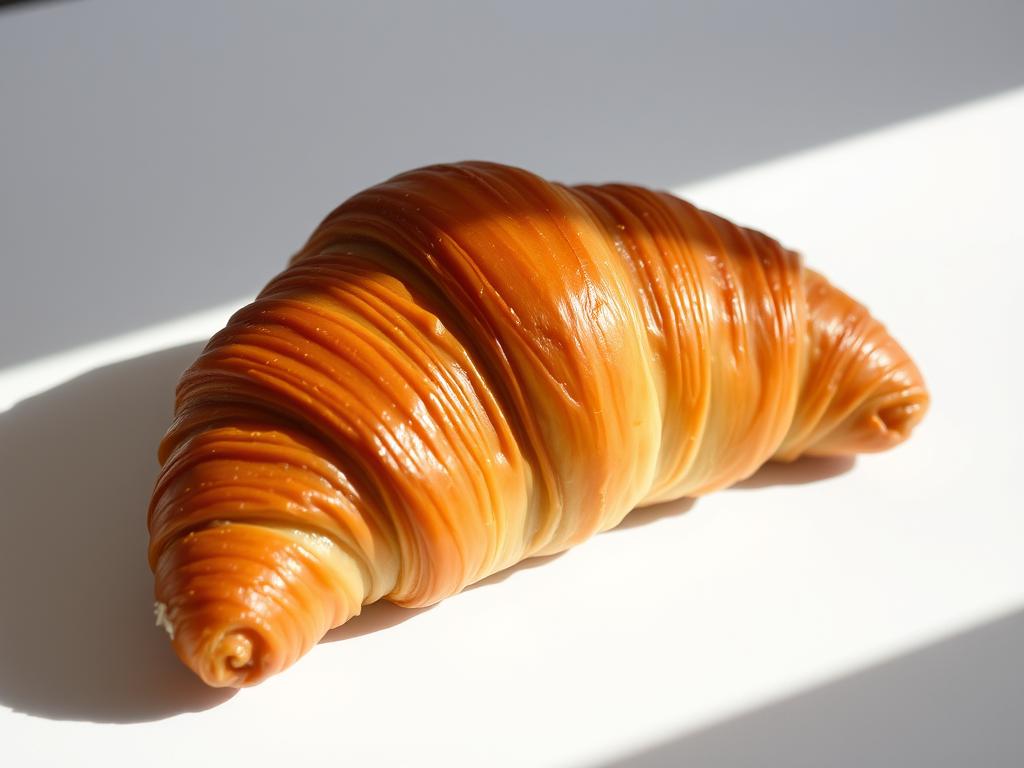
1 thought on “Baked Cheese Croissant: A Flaky Delight”
Comments are closed.